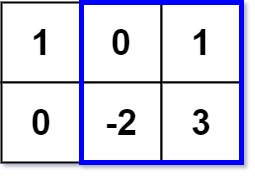LeetCode-in-Java
363. Max Sum of Rectangle No Larger Than K
Hard
Given an m x n matrix matrix and an integer k, return the max sum of a rectangle in the matrix such that its sum is no larger than k.
It is guaranteed that there will be a rectangle with a sum no larger than k.
Example 1:

Input: matrix = [[1,0,1],[0,-2,3]], k = 2
Output: 2
Explanation: Because the sum of the blue rectangle [[0, 1], [-2, 3]] is 2, and 2 is the max number no larger than k (k = 2).
Example 2:
Input: matrix = [[2,2,-1]], k = 3
Output: 3
Constraints:
m == matrix.lengthn == matrix[i].length1 <= m, n <= 100-100 <= matrix[i][j] <= 100-105 <= k <= 105
Follow up: What if the number of rows is much larger than the number of columns?
Solution
public class Solution {
public int maxSumSubmatrix(int[][] matrix, int k) {
if (matrix == null || matrix.length == 0 || matrix[0].length == 0) {
return 0;
}
int row = matrix.length;
int col = matrix[0].length;
int res = Integer.MIN_VALUE;
for (int i = 0; i < col; i++) {
int[] sum = new int[row];
for (int j = i; j < col; j++) {
for (int r = 0; r < row; r++) {
sum[r] += matrix[r][j];
}
int curr = 0;
int max = sum[0];
for (int n : sum) {
curr = Math.max(n, curr + n);
max = Math.max(curr, max);
if (max == k) {
return max;
}
}
if (max < k) {
res = Math.max(max, res);
} else {
for (int a = 0; a < row; a++) {
int currSum = 0;
for (int b = a; b < row; b++) {
currSum += sum[b];
if (currSum <= k) {
res = Math.max(currSum, res);
}
}
}
if (res == k) {
return res;
}
}
}
}
return res;
}
}

